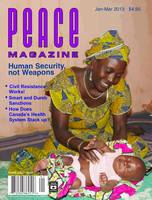
Peace Magazine January-March 2013, page 18. Some rights reserved.
Search for other articles by Hippu Salk Kristle Nathan here
The United Nations is mandated to raise the awareness that disarmament is the key to a peaceful world. Has it succeeded in this?
Hardly. In 2000, its disarmament exhibit showcased an inverted triangle called “Overspending on Weapons vs. People,” which depicted the world’s misplaced priorities—the overemphasis on arms and ammunitions. The top part of the triangle showed annual military world expenditures—about $800 billion.
The bottom part, which was about one-fourth the size of the top, represented all humanitarian and developmental expenses, such as shelter, clean energy services, water, health care, elimination of starvation and illiteracy, prevention of ozone depletion, deforestation, global warming, acid rain, stabilization of population and strengthening of democratic instructions.
According to the Stockholm International Peace Research Institute (SIPRI) by 2011 the world annual military expenditure had more than doubled to reach $1,735 billion. By the latest SIPRI statistics, the largest five military spenders are the US, China, Russia, the UK, and France. These countries are none other than the five permanent members of the UN Security Council, and together they account for 65 of the total global military expenditure.
In the past three years (2008-11) India, with a military spending of $48.9 billion has moved from tenth to the seventh position among all countries. India has also become the world’s largest arms importer, with almost 12 of the global share. This is a dubious distinction, as India gained independence 65 years ago through Gandhi’s path: nonviolence. Today India’s Human Development Index (HDI) ranks 134th among 187 countries, according to the latest human development report of the United Nations Development Program (UNDP). Its low HDI rank indicates that India needs to give priority to developmental needs: offering its citizens a long and healthy life, knowledge, and a decent standard of living.
Like India, Pakistan also has a poor HDI rank (145th). However it is the third in arms imports with 5.6 of the world share. Similarly, Morocco has a HDI rank of 130, yet is fourth in arms imports.
If these less developed economies are importing arms, which ones are exporting them?
Among the top six arms exporters are the five permanent members of the UN Security Council. The US has a 33 global share in arms export, followed by Russia (26). Respectively, France, China and UK have global shares of 8.1, 4.5 and 3.6 in arms export. So the UN Security Council members are producing more arms than they need for domestic purposes and exporting the surplus to other countries as a business.
Here we see the conflict of interest between the UN’s agenda and the trade agendas of the countries controlling the UN. On one hand the UN Security Council members are to strive for a united and peaceful world, but on the other hand a more divided, disturbed, violent, and war-prone world suits their military and commercial interests. The UN Security Council permanent members are supposedly guardians of peace.
With the highest defense budgets and arms exports these countries are also promoters of war. Thus disarmament will remain a distant dream. It is time to realize that the goal of disarmament can be achieved only by actually disarming.
Dr. Hippu Salk Kristle Nathan, happyhippu@gmail.com is a postdoctoral associate at National Institute of Advanced Studies (NIAS), Bangalore, India.

Peace Magazine January-March 2013, page 18. Some rights reserved.
Search for other articles by Hippu Salk Kristle Nathan here